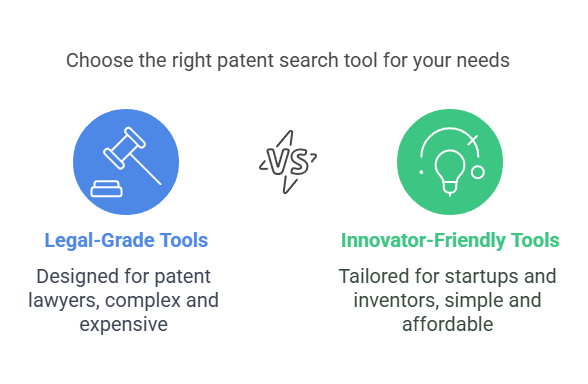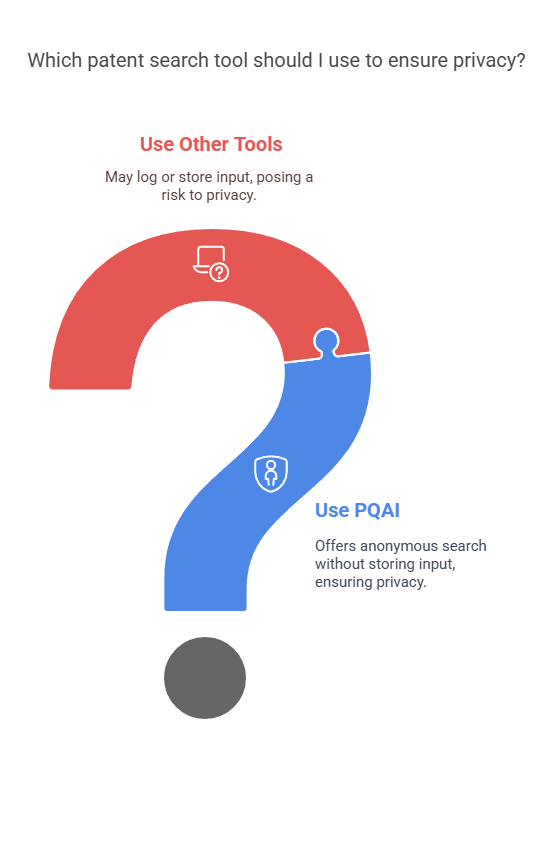
What should I do if an error occurs or my API request fails?
Running into an issue like API errors, expired tokens, or unexpected timeouts? Here are a few simple steps you can follow to resolve them quickly.

You have an idea. Maybe it is groundbreaking. Perhaps it simply solves a real problem more effectively than what currently exists. Before you spend time and money filing a patent, there is one critical step: making sure someone else has not already claimed it. That is where a patent search tool comes in.
But the moment you start looking, you are hit with a wall of options. Google Patents, Espacenet, commercial platforms with five-figure price tags. Some say they use AI. Some expect you to write Boolean queries. Others look like they were built in the early 2000s.
If you are a startup founder, an inventor, or someone navigating IP for the first time, you do not need a legal-grade search engine. You need something that fits your goals. Something that helps you validate your ideas, discover prior art, and move forward with confidence.
In this guide, we will show you how to make that decision. This is not a list of “how to choose the best patent search tools” written for patent lawyers. It’s a 7-point checklist designed for innovators like you. People who want to find the right patent search tool for their needs, budget, and stage of invention. Let’s get started.

Most inventors are not patent lawyers or power searchers. Yet many traditional tools expect you to search using structured legal language, CPC codes, or complex Boolean queries. This complexity can lead to missed prior art, while wasting time and resources.
However, in this era of LLMs and smart tools, an inventor should be able to describe their idea using plain English and get relevant information.
With so many commercial tools boasting AI features today, natural language input is something you should look for in your search tool. A good search tool should be able to understand context, not just match keywords.
For instance, when an inventor described a “lightweight, portable Bluetooth speaker with an in-built light that glows like a real flame together with your music,” PQAI effectively identified a closely related patent titled “Portable Bluetooth Camping Light.”

Natural language processing can bridge the gap between your description and the prior art hiding in millions of documents. The best tools in the market use semantic matching, concept extraction, and vector-based retrieval to surface similar inventions, even if they use entirely different terminology. That is how a modern patent search tool should work in 2025.
You should not need a training manual to run your first patent search. Yet many tools feel like they were designed for power users running their 100th search. Not inventors or founders like you exploring your ideas.
Further, poor interfaces, nested filters, and hidden features often discourage users from going beyond surface-level results. That is a problem. Because a tool that is difficult to use is one that is not used properly. This can lead to missed prior art or misplaced confidence in a weak patent filing.
The ideal patent search tool should feel intuitive. You should be able to run a search, check results, and explore further, without needing a help guide. The best tools today prioritize usability alongside search intelligence.
A patent search tool is only as powerful as the databases it pulls from. Some free tools give you access to a limited pool of documents. That means you could miss patents filed in countries like China, Korea, or Japan. Or overlook older patents that have already expired.
Coverage gaps like these can cause major blind spots. For an accurate novelty or prior art search, your tool should include comprehensive global coverage. This includes major patent offices such as the USPTO, EPO, WIPO, CNIPA, and JPO. It should also account for expired patents. Prior art is valid whether it is enforceable today or not.
However, patents are only part of the story. Some of the strongest prior art exists in technical papers, journals, whitepapers, and preprint archives. These are known as non-patent literature, or NPL. If your tool ignores them, you may miss the very documents that matter most.
A good tool does not just search globally. It searches broadly across jurisdictions and across both patent and non-patent literature.
Finding results is only step one. What matters more is knowing which of them actually matter.
Reading patent documents is not always easy. The language is dense. The structure is unfamiliar. And most tools leave it to you to determine whether a result is relevant or just noise.
That is why a good search tool should help you make that judgment faster. It should show you how each result connects to your input. This could mean side-by-side comparisons, summaries of key features, or highlighted overlaps between your idea and the matched invention.
For instance, tools like PQAI show mapping of user queries to reference text in descriptions or patent claims.

The right tool helps connect the dots between your idea and the prior art around it.
Your first search is rarely your final answer. As your idea evolves, you will need to tweak your description, rerun searches, and check for new overlaps. That is part of the invention process.
The best search tools naturally support this. They let you go back, adjust your input, and explore new directions without forcing you to start over. Some even help you understand how different versions of your idea connect to the same prior art.
For example, if your original search was about a “smartphone case that cools the device,” and you later modify it to “passive thermal management for handheld devices,” your results should still make sense. You should not have to rebuild your entire search strategy.
This kind of flexible, context-aware refinement is especially important. You should be able to rephrase your input, test new variations, and see the results update in real time. Whether you are tightening your language or rethinking the idea itself, your search tool should be able to keep up.
Patent search should not feel like a black box. If a tool shows you a list of documents, but you cannot tell why they appeared, it becomes difficult to trust what you are seeing.
Some results may match your input word-for-word. Others may be conceptually similar but use different terms. Some may just share a classification code or general topic. Without clarity on why something showed up, you are left guessing.
This is why explainability matters. A good search tool should reveal what triggered each result. Did it match specific phrases? Did it detect overlapping technical concepts? Was there a functional similarity?
The best tools today help connect these dots. They may highlight matched keywords, extract and compare core ideas, or show relevance scores linked to your input.
Think of it like using a navigation app that gives you a route but no explanation. Would you take that road blindly? Or would you want to know the reason – traffic, distance, road closures – so you can trust the path?
The same logic applies here. The more you can see why a result surfaced, the more confident and capable you become as a searcher.
Before you file a patent, your idea is private. And unprotected. The moment you type it into a search tool, you are handing it over to someone else’s system.
Many tools do not tell you what happens to your input. Some may log your queries. Some may use them for analytics. Some may even store that data for backend improvement without explicitly saying so.
That is a risk. If you are searching before filing a provisional patent, you do not want that idea sitting in a database somewhere.
The right idea for inventors like you would be to find tools that let you search anonymously. It is important to check the platform’s privacy policy. And then carry out your search on the tool that does not store or reuse your invention text.

Did you know: PQAI does not log, track, or store your input. You can search completely anonymously. Login is not required, and your invention stays private, secure, and entirely on your screen.
This checklist is not intended to cover every possible feature a patent search tool must have. Features like export formats, pricing models, collaboration tools, or legal system integrations matter too. Especially as your idea matures.
But they should not be your starting point. If you are an inventor or a startup founder, your focus should be on what matters most at this stage: relevance, usability, transparency, coverage, and control.
This checklist is built to help you find a tool that supports early innovation without overwhelming you with complexity.
Think of this checklist as a strong foundation. Once you have these seven boxes checked, everything else becomes easier to evaluate. You can get a PDF copy of this checklist here.
If you are looking for a patent search tool that checks the boxes we’ve discussed above, the PQAI tool is worth exploring.
PQAI is an open-source, AI-powered patent search platform designed with inventors like you in mind. It lets you describe your idea in natural language and returns relevant prior art from a vast database of U.S. patents and scholarly articles.

Source – PQAI
The key features of the PQAI tool include:
PQAI is not just another AI-powered patent search tool. It’s part of a collaborative initiative to make patent searching more accessible and efficient for everyone. Whether you’re refining an idea or preparing to file, PQAI can help you navigate the prior art landscape with confidence. Get started with a quick search to discover PQAI’s amazing capabilities. Try the tool here.
Yes. In fact, you should. A basic search before filing can help you catch overlapping inventions and refine your claims. But you should exercise caution, as your idea is not protected until filed. A good idea would be to use tools that let you search anonymously and do not store confidential invention details.
They are getting better every year. Good AI tools do not just match keywords; they understand concepts, synonyms, and technical language. For inventors and founders looking to explore novelty of their ideas, AI tools are a good choice. However, for critical decisions, pair AI insight with human review or professional advice.
The privacy policy should be the first thing to check. It is a good idea to avoid tools that require a login just to search. Be cautious if the platform does not clarify whether it logs or stores your input. If your idea is not filed yet, choose tools that allow anonymous searching and clearly state that they do not track your data.
PQAI is one of the safest tools for carrying out your patent search. Want to know how to make the best use of it? This video will help.
Share

Running into an issue like API errors, expired tokens, or unexpected timeouts? Here are a few simple steps you can follow to resolve them quickly.

PQAI is built with privacy and security at its core. Unlike general-purpose AI tools, it is purpose-built for patent search and does not ingest or

No, PQAI does not store or track your search queries. As soon as your results are generated, your query is erased from our servers. Here’s
© 2025 Project PQAI | All Rights Reserved.
Dear PQAI Team,
We are pleased to express our support for PQAI and its mission to revolutionize patent searching through open-source, AI-driven solutions.
At [COMPANY NAME], we recognize the importance of accessible and efficient patent tools in fostering innovation and empowering inventors from diverse backgrounds. By supporting PQAI, we aim to contribute to the development of transparent, collaborative, and impactful solutions for the intellectual property community.
We kindly request the addition of [COMPANY NAME] to the official List of Supporters of PQAI.
Sincerely,
[CEO or Equivalent Name]
[Title]
[Company Name]
[Signature]